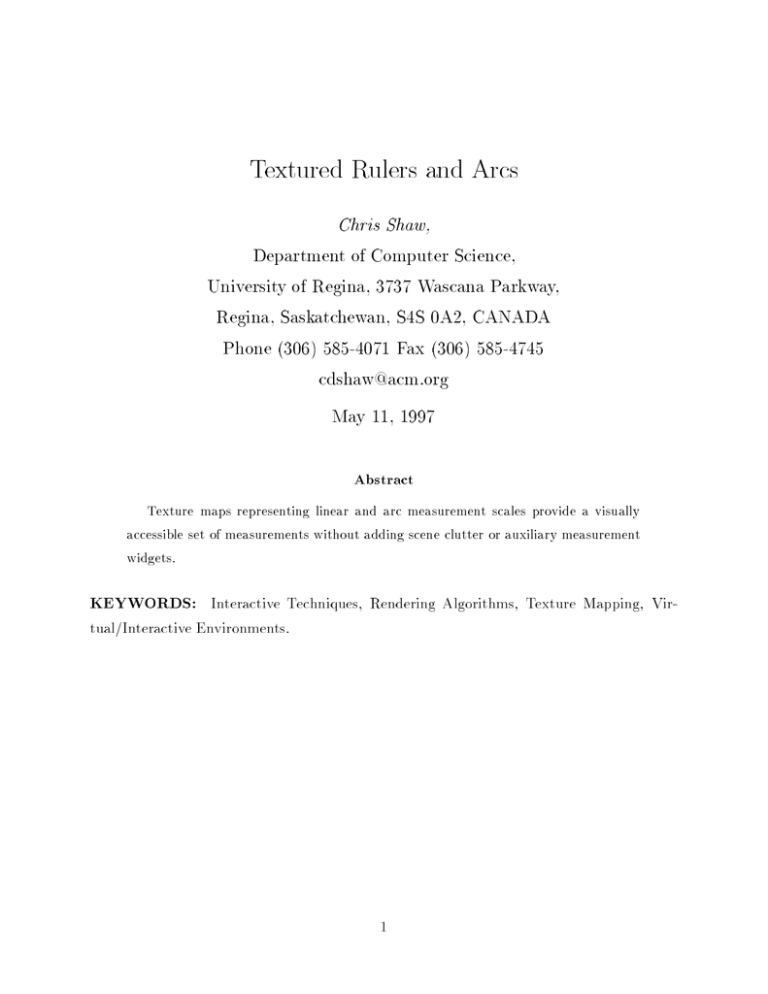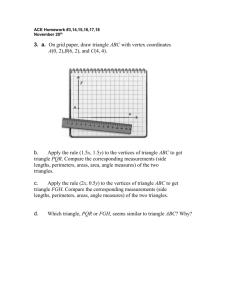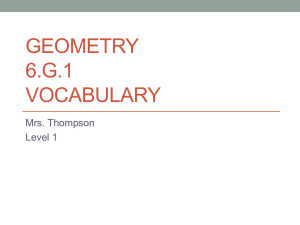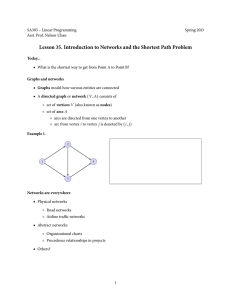Department of Computer Science, University of Regina, 3737 Wascana Parkway,
advertisement

Textured Rulers and Arcs
Chris Shaw,
Department of Computer Science,
University of Regina, 3737 Wascana Parkway,
Regina, Saskatchewan, S4S 0A2, CANADA
Phone (306) 585-4071 Fax (306) 585-4745
cdshaw@acm.org
May 11, 1997
Abstract
Texture maps representing linear and arc measurement scales provide a visually
accessible set of measurements without adding scene clutter or auxiliary measurement
widgets.
Interactive Techniques, Rendering Algorithms, Texture Mapping, Virtual/Interactive Environments.
KEYWORDS:
1
Textured Rulers and Arcs
Chris Shaw
1 Textured Rulers and Arcs
In designing or examining free-form surfaces or polygonal objects, there is often a need to
display linear dimensions of the object, especially when the object must t with other objects,
as in the case of mechanical or industrial design. The standard technique of underlaying axisaligned grids for measurement is convenient only in an orthographic view. In a perspective
scene, a shadow of the object can be orthographically projected onto surrounding walls that
contain a grid 1]. One measurement at a time can also be provided by an inquiry function,
where the user temporarily attaches a measurement widget to the desired objects, but the
widget will obscure the objects. For general angle measurement, almost the only choice is a
3-point measurement widget that will obscure part of the scene while reading out the angle.
The approach suggested in this sketch is simply to mark the surface directly with texturemapped measurement tools. In a similar technique, SGI has a demo that maps a regular
grid texture onto a bicubic patch to show its (u,v) parameter space. The main advantage
with this approach is that input clutter is eliminated, because there are no widgets to avoid
clicking. Instead, the surface is painted with measurements which can be turned on or o
as a rendering attribute. Output clutter is also reduced because the measurements occupy
the identical space as the object being measured, meaning that the measurements cannot
occlude other objects in the scene. Because images are textured onto the surface, potentially
hundreds or thousands of measurements are available simultaneously to the user { the user
simply has to look at the points of interest to learn the dimension of interest.
To measure the edge lengths of polygon P , a bilevel ruler texture is applied to each edge.
An inner inscribed polygon is generated in the plane of P , and for each edge a 4-sided ruler
quad is generated to hold the texture. For example, a triangle would be divided into an
inscribed triangle and 3 ruler quads.
For angle measurement, the bilevel arc texture map is used, which is essentially a protractor with heavy tickmarks at 10 degree intervals (Figure 1). For each angle of the polygon
to be measured, the axis of this protractor image (at the center of the bottom edge) is placed
at the vertex, with the line marked 0 located along the edge lying counter-clockwise from
the vertex. To apply the arc at each vertex, the polygon must be cut into subpolygons with
the arc texture applied to each, as shown schematically in gure 1. For a triangle, each
subpolygon is a quadrilateral that is made up of the main triangle's vertex, the midpoint
of each incident edge and the centroid of the main triangle. Both arcs and rulers can be
1
Textured Rulers and Arcs
Chris Shaw
displayed at the same time, in which case the texturing occurs using the inscribed vertex
values for the edge and centroid calculations.
Figure 1: Left: Protractor texture applied at the vertex of each triangle.
Middle: Subdivision of a triangle into 3 subpolygons so that the arc texture can be drawn
at each vertex.
Right: An example surface. Clockwise from top left: two quads with arcs applied to each
vertex of each component triangle, a quad with rulers and arcs, and a quad with just rulers.
This new scheme of textured annotations on the surface of objects is quite eective at
providing users with ready access to salient metrics on the surface. In an experiment which
required subjects to build a simple object to precise dimensions, subjects were readily able to
visually access linear measurements provided by the texture-mapped rulers. Subjects could
quickly tell that they had reached the correct length.
In a surface with hundreds or thousands of quads in the mesh, each quad can be textured
with rulers and arcs, making the linear dimensions of each quad visually available simultaneously without cluttering the scene with auxiliary measurement dialogs. This new texturing
method eliminates input clutter and reduces output clutter.
References
1] K P Herndon, et al. Interactive Shadows. In UIST 1992 Proceedings, pages 1{6, 1992.
2






